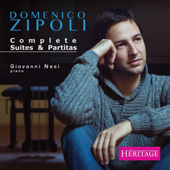
ESSENTIAL RECORDINGS

Domenico Zipoli, an Italian Jesuit composer of the Baroque era, is justly celebrated for the liturgical music he produced in South America. Less familiar, although popular at the time, are
the secular works he composed in Italy in the early 18th century. His collection 'Sonate d’intavolatura', charming and tuneful in style, contains both suites and partitas for
keyboard. Giovanni Nesi gives world premiere performances of these works on the modern piano. {Héritage}
During my many years as a church organist, I stumbled upon a few organ pieces by Domenico Zipoli (1688-1726) which I found to be melodically innovative and stimulating,
and played most of them on a regular basis. As a matter of fact, I still play his Canzona in G minor on occasion. He was a contemporary of Johann Sebastian Bach
and the similarities are plentiful. The fact that he died young and spent most of his adult years as a missionary in South America may have contributed to his relative obscurity. I myself never found
the time to further explore and investigate his music, but having now had the chance to hear this wonderful recording by Giovanni Nesi my curiosity has certainly been rekindled.
Zipoli's music may not seem as lofty and erudite as the German master's output, but I would safely say that it's on the same level of craftmanship as the Well-Tempered Clavier (minus the fugues
of course). What it lacks in counterpoint it certainly makes up for in its melodic beauty which Giovanni Nesi projects very well. The Sarabande from the
Suite No. 2 in G minor is but one example of many in which an inspired moment or two bring a touch of inventive genius to the foreground. And as you move
up through the Suites, you can actually feel the maturity and craftmanship of the writing evolve from one to the next. So much so that in the Allemande from the
Suite No. 4 in D minor you can hear forward momentum techniques that Beethoven would use a century later. Grace, nobility, and especially melodic beauty,
are key elements of this music. These works were originally written for the harpsichord, but their expressive warmth and melancholy colors are much more suited to the piano. Hats off to
Giovanni Nesi for giving us the pleasure.
Jean-Yves Duperron - November 2015